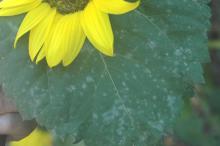Cause The fungi, Golovinomyces cichoracearum (formerly Erysiphe cichoracearum), has been reported from Idaho and Washington and G. spadiceus has been reported from Washington. Podosphaera xanthii and G. ambrosiae are also reported to occur on Helianthus spp. in North America.The disease has been found on a single plant sample sent to the OSU Plant Clinic. The fungus, reported to overwinter as chasmothecia on plant residue, is favored by conditions that produce high humidity but dry leaves. It is a highly specialized pathogen that forms a close association with the host. Conditions that favor the host also favor the pathogen. Much of the fungus remains outside infected plant parts where it grows on the surface but sinks root-like structures called haustoria into plant cells to obtain nutrients. The white growth seen is composed of both mycelium and fungal spores.
Symptoms White powdery areas appear on lower leaves first. All other aboveground plant parts may be affected. White areas turn gray, and small black fruiting bodies (chasmothecia) of the fungus appear in the gray areas. Severely infected leaves may turn yellow and dry up. Generally, lower leaves remain more heavily infected than upper leaves.
Cultural control
- Space plants for good air circulation.
- Remove and destroy plant debris at the end of the season.
- Plant in an area that receives full sun most of the day.
Chemical control Some labels may not allow seeds from treated plants to be used for food or feed. Fungicides will do best when used before symptoms develop. Few materials have good eradicant activity Use at 7- to 14-day intervals; using shorter intervals when environmental conditions favor disease development. Alternate or tank-mix products from different groups that have different modes of action. Limit the use of any one group during crop production.
- Aproach at 6 to 12 fl oz/A plus a surfactant. Do not use more than 3 applications or within 7 days of harvest. Group 11 fungicide. 12-hr reentry.
- Eagle 20 EW at 6 to 12 fl oz/100 gal water. Seed from treated plants may not be used for feed or food. Group 3 fungicide. 24-hr reentry.
- Myclobutanil 20 EW T&O at 6 to 12 fl oz/100 gal water plus spreading agent. May observe a PGR effect. Group 3 fungicide. 24-hr reentry.
- Safer Brand Garden Fungicide (Ready To Use 0.4% sulfur) thoroughly sprayed over the entire plant. Do not use when the temperature is over 85°F or within 4 weeks of an oil spray. H
- Spectracide Immunox Multi-Purpose Fungicide Spray Concentrate for Gardens at 1 fl oz/gal water. Not for food use. Group 3 fungicide. H
- Thiolux (80% sulfur) at 3 to 10 lb/A. Group M2 fungicide. 24-hr reentry. O
- Vertisan at 10 to 30 fl oz/A on 7- to 14-day intervals. Preharvest interval is 14 days. Group 7 fungicide. 12-hr reentry.
Reference Moparthi, S., Bradshaw, M.J., and Grove, G.G. 2018. First report of powdery mildew caused by Golovinomyces spadiceus on Helianthus annuus. Plant Disease 102:1176-1177.
Saliman, M., Yang, S.M., and Wilson, L. 1982. Reaction of Helianthus species to Erysiphe cichoracearum. Plant Disease 66:572-573.

